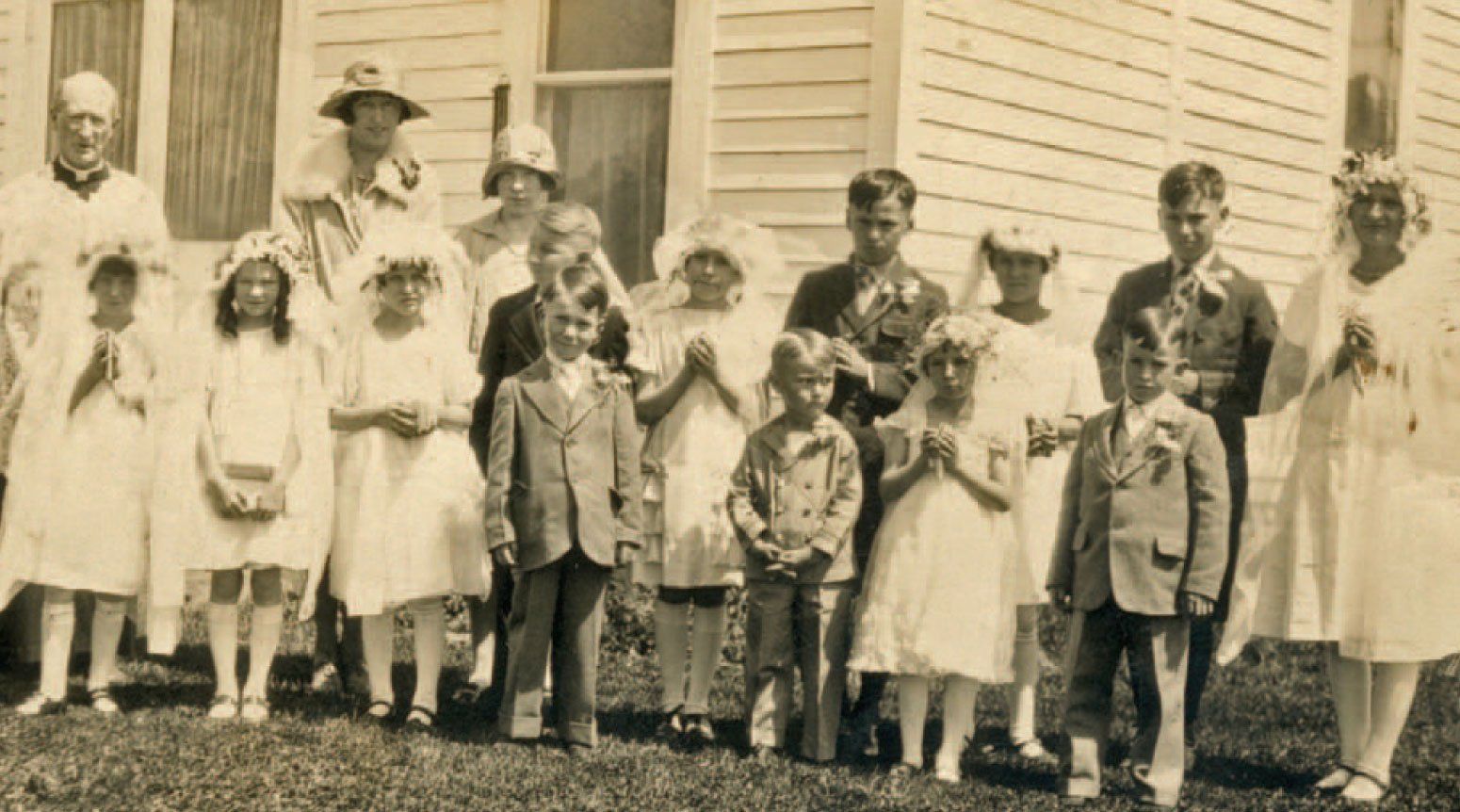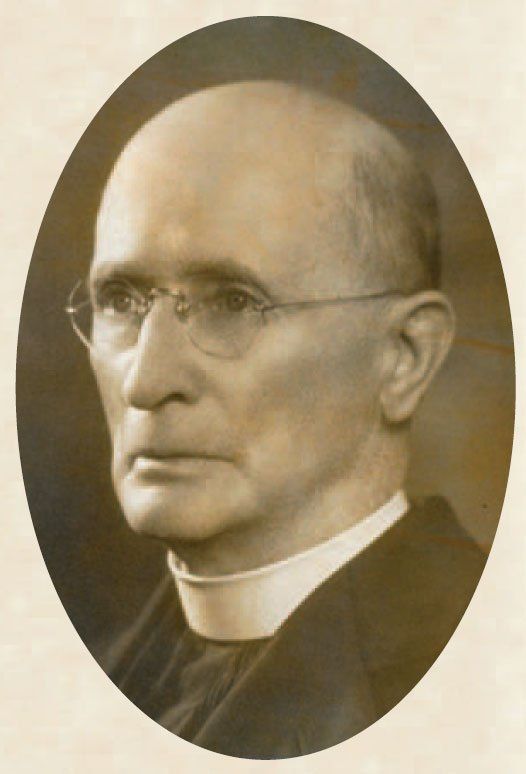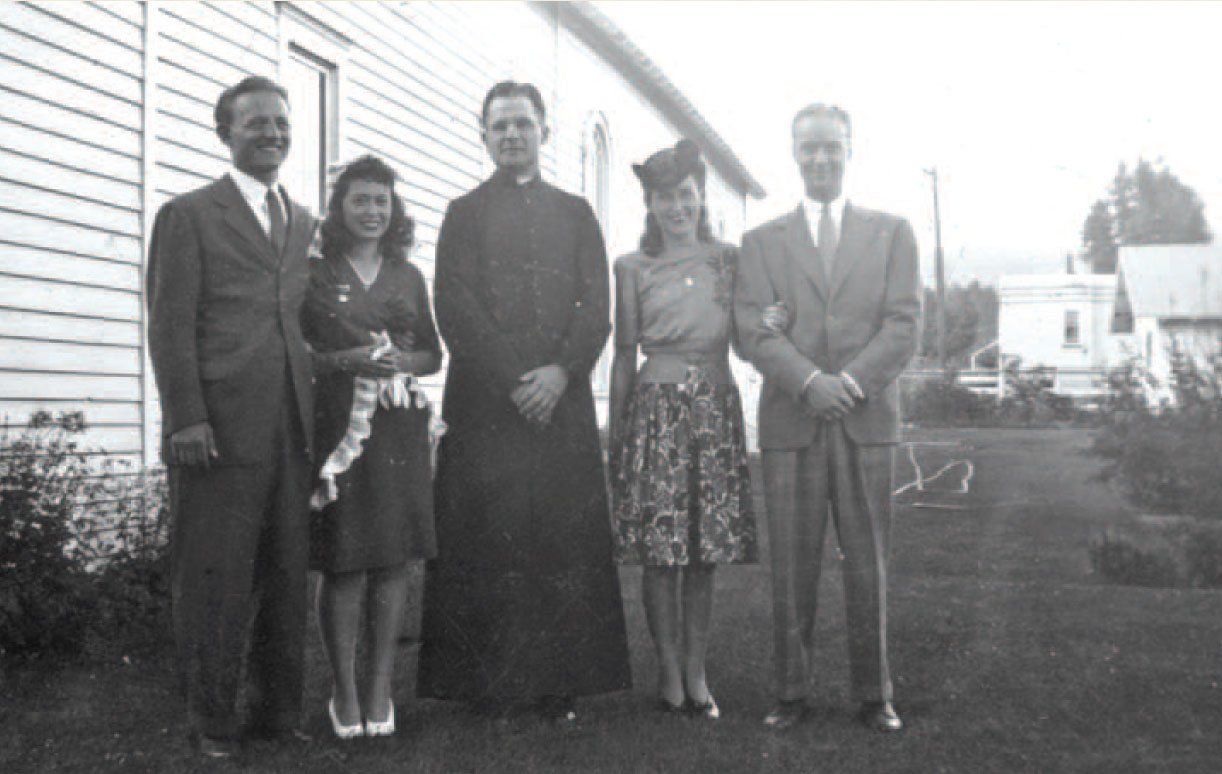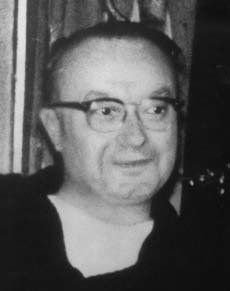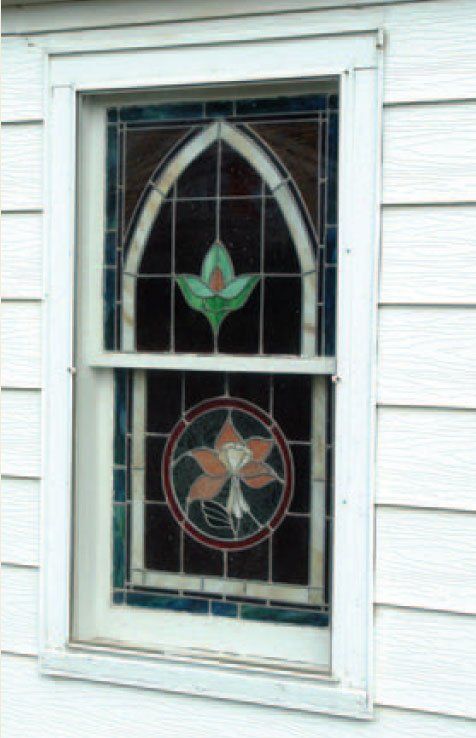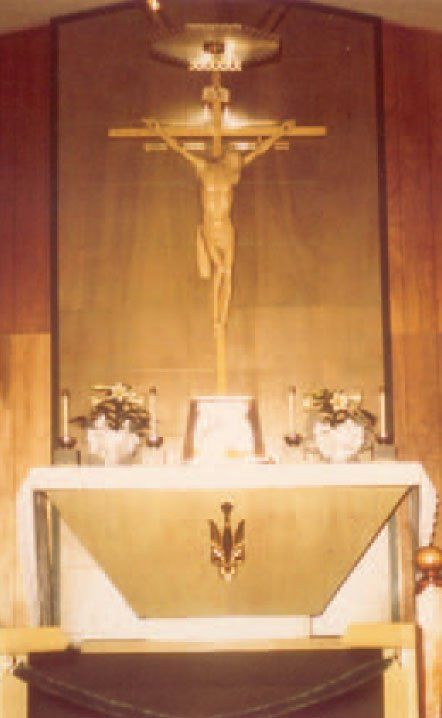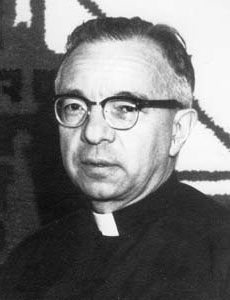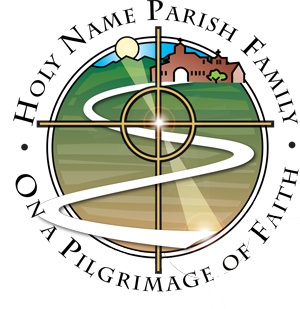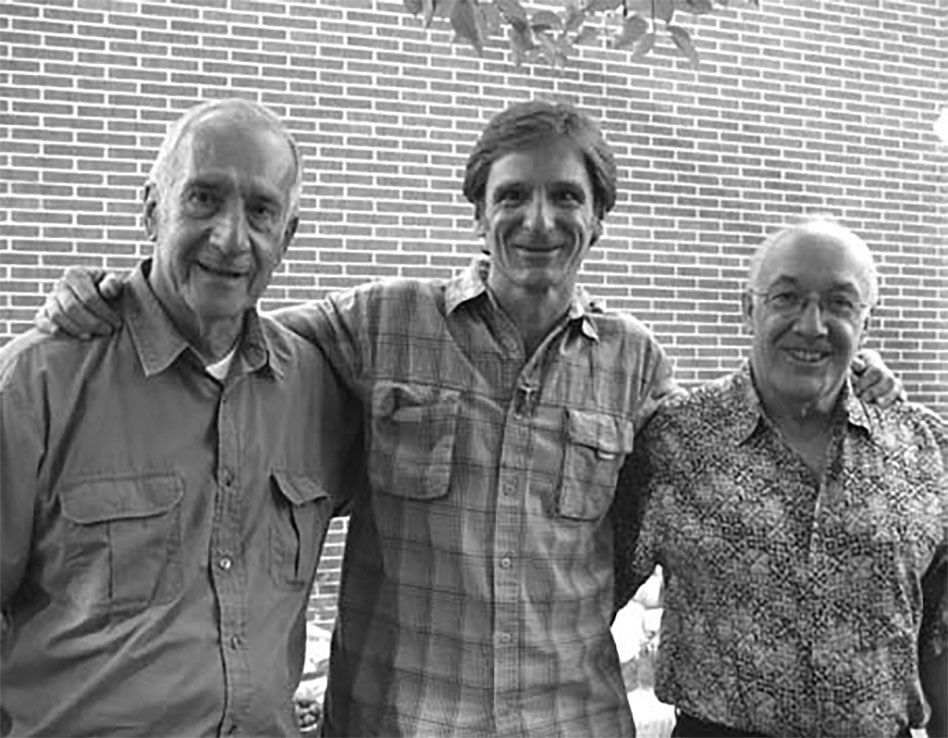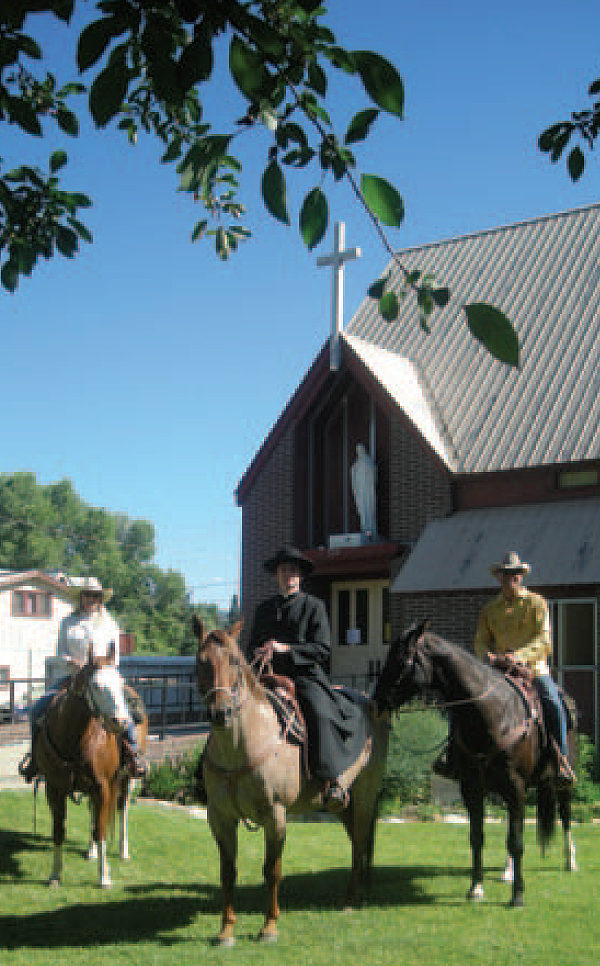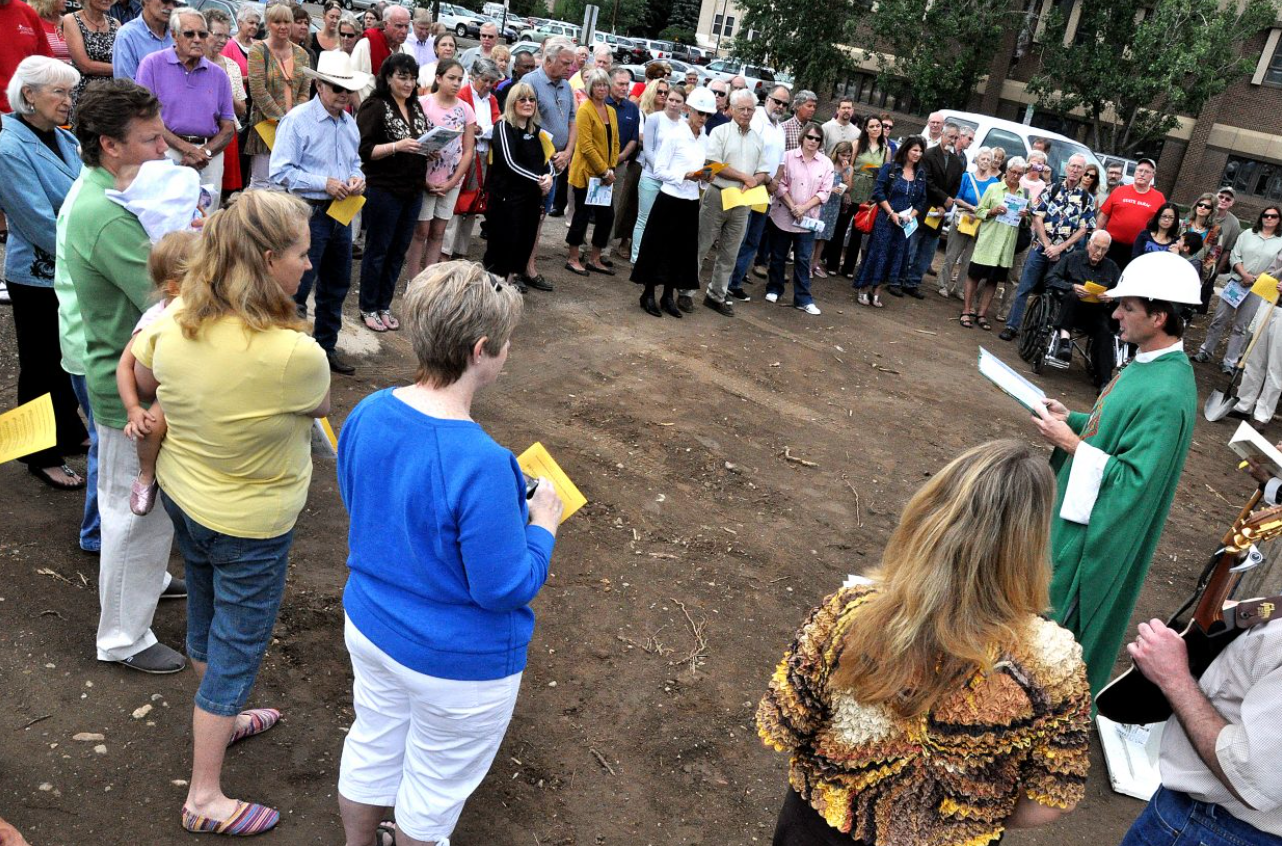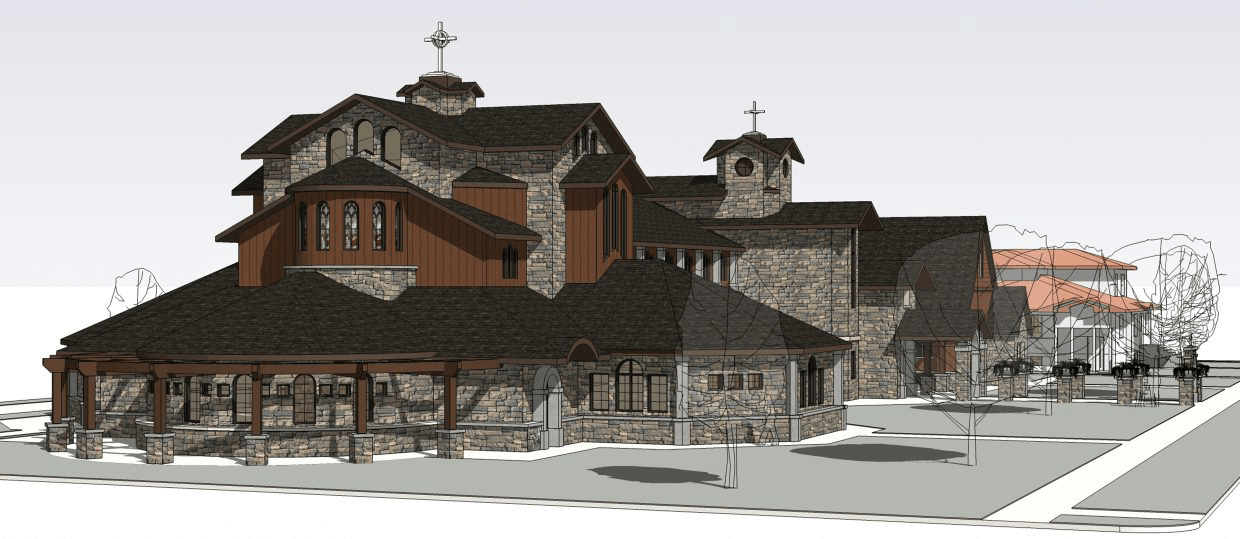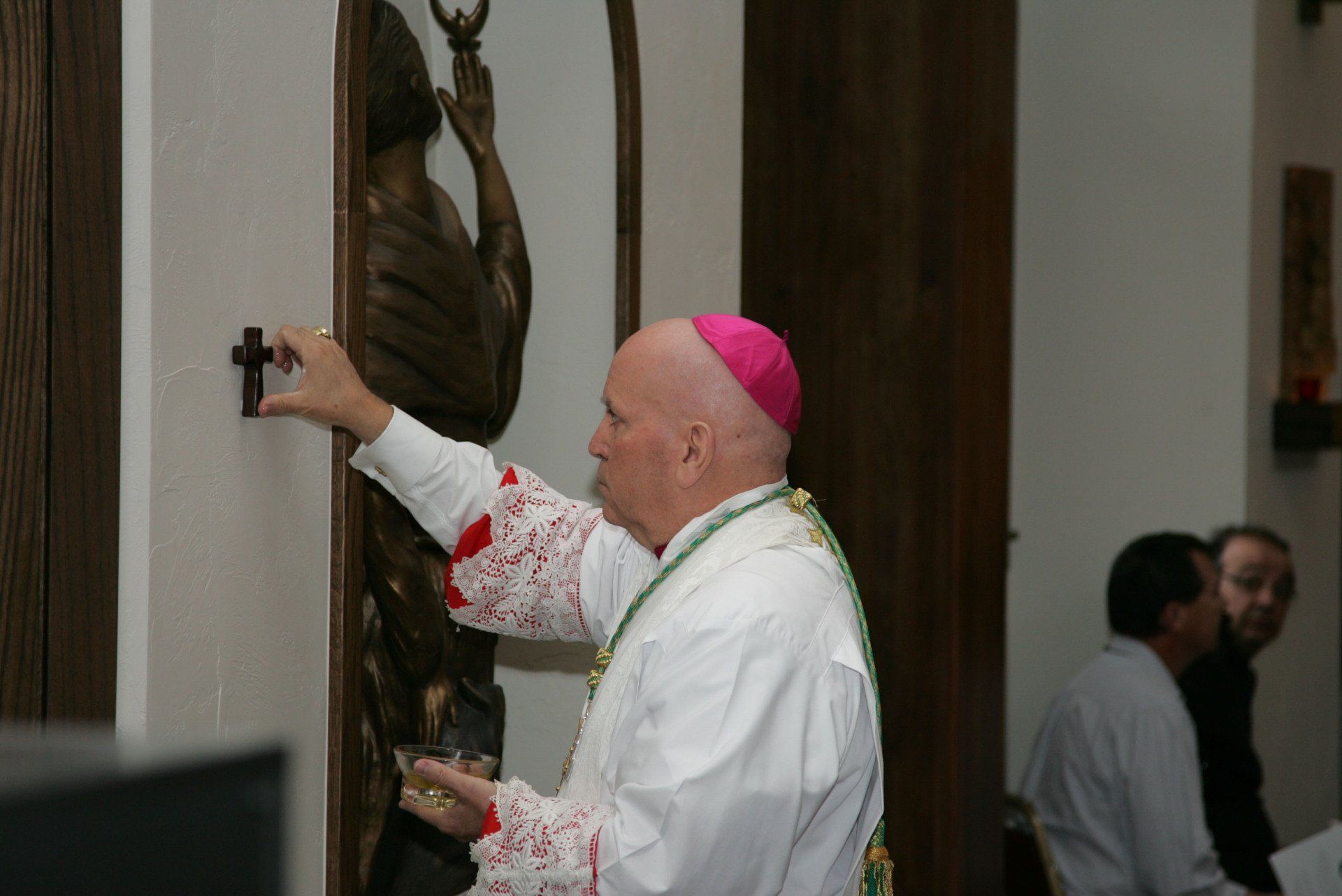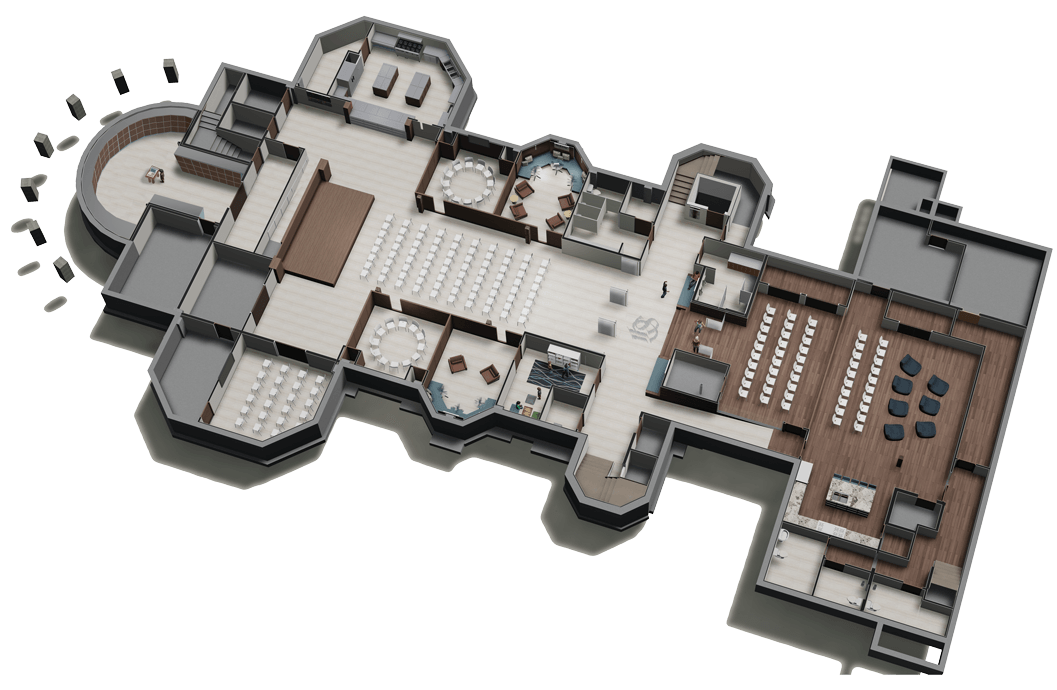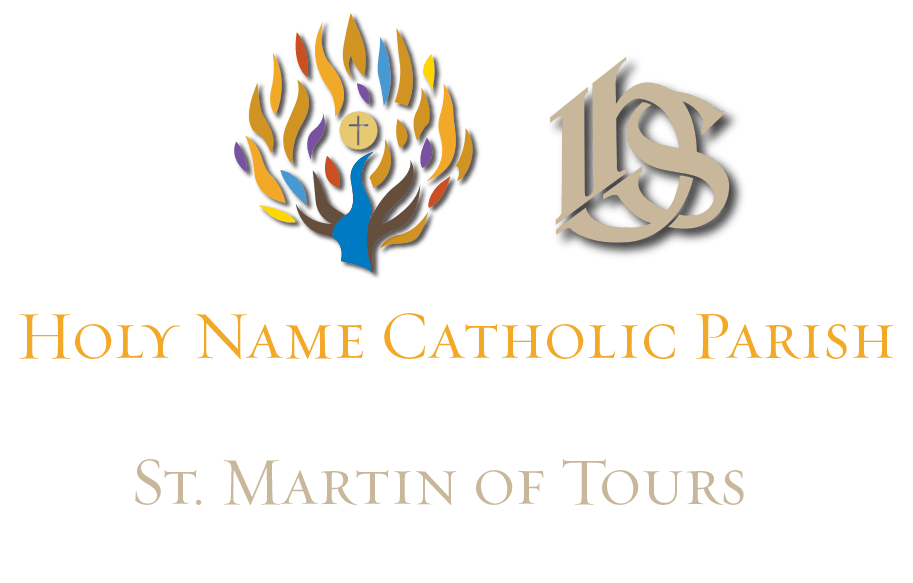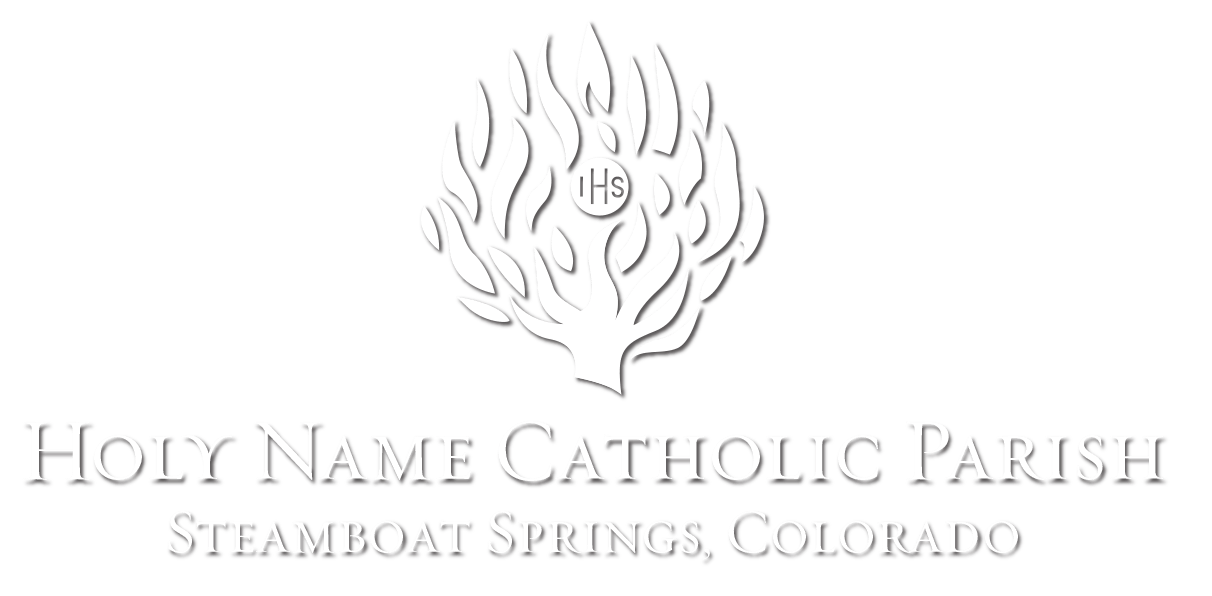
Since 1907, the Eucharist has been celebrated in Routt County. . .
Timeline:
1880 . . .
Father Nicholas Matz, later Bishop of Denver and Father William J. Howlett
visit Routt County.
1881 . . .
Father Eis, later Bishop of Marquette, Michigan, makes a missionary trip through
the territory.
1907 . . .
Population in 1900:
Routt County: 3,661; Colorado: 539,700
Reverend J. J. Meyers takes charge of Northwest Colorado Catholic missions.
When the railroad arrives in Steamboat Springs, he establishes Holy Name Catholic Church there. The town of Oak Creek is founded this year & Father Meyers begins celebrating the Eucharist there as often as possible.
1908 . . .
Population in 1910:
Routt County: 7,561; Colorado: 799,024
The first Catholic Church for Holy Name Parish is erected in Steamboat.
It includes living quarters for the pastor in the vestibule.
1939 . . .
Population in 1940:
Routt County: 10,525; Colorado: 1,123,296
Father Edward Prinster is appointed administrator of Holy Name Catholic Church
in Steamboat.
1941 . . .
A church is built in Oak Creek under the patronage of St. Martin of Tours and South Routt parishioners finally have a home. Up until this time, the Eucharist had been celebrated in the Halbert Home & the local mortuary.
1948 . . .
Population in 1950:
Routt County: 8,940; Colorado: 1,325,089
Father Prinster has Holy Name Church renovated and ads a rectory for the cost of $28,000.
1956. . .
Tragedy strikes the parish on December 12th when Father Prinster falls to his death while removing snow from the roof of the rectory.
1960 . . .
Population in 1960:
Routt County: 5,900; Colorado: 1,753,947
Plans to build a new church in Steamboat are announced.
The old church will be remodeled and used for religion classrooms.
The drive to raise $100,000 in building funds is initiated.
1964 . . .
Ground is broken for a new Holy Name Church building in Steamboat.
Renovations and additions begin at St. Martin of Tours in Oak Creek.
December 22:
The first Eucharist in the new Holy Name Church is celebrated in
the Blessed Sacrament Chapel.
Christmas Eve: The first Eucharist is celebrated in the main church.
1970 . . .
Population in 1970:
Routt County: 6,592; Colorado: 2,207,259
1983 - 1993
Msgr. Tom Dentici serves as pastor of Holy Name and St. Martin's.
He and the Finance Council decided to buy the three small houses on the end of the block to allow for future expansion of the church.
1993 - 2005
Msgr. George Schraeder serves as pastor of Holy Name and St. Martin of Tours.
He began a capital fund and preliminary architectural plans for a church expansion.
2005 . .
Fr. Ernest Bayer becomes administrator of Holy Name and St. Martin of Tours.
2006 . . .
Routt County Population in the year 2000: 19,690
Nearly 3 times the number of residents than when the church of 1964 was built,
and a 39.8% increase over 1990.
October 2006. . .
Father Ernest Bayer (now pastor) announces the formation of a committee to explore the possibilities of enlarging the 42 year-old Holy Name Church to better accommodate the area’s larger population and its multitude of Catholic visitors.
2008 . . .
An economic recession threatens to delay the church expansion, but donations continue to promise a building project to revive the local economy.
The Archdiocese of Denver approves the expansion plans.
2012 . . .
A Groundbreaking Ceremony begins the construction.
Demolition of a third of the standing church and removal of three buildings on the north end of the property.
2014 . . .
The new Holy Name Church is completed in Steamboat Springs.
Archbishop Samuel J. Aquila consecrates the church at a solemn Mass on the Feast of the Exaltation of the Cross, September 14. The project was fully funded without the need for a loan, thanks to the miraculous generosity of the parishioners and visitors.
2018 . . .
Fr. Ernest forms a committee to develop plans for Phase 2 of the building project:
To develop the basement beneath the church into a multi-purpose facility named
the Enrichment Center begins.
March 2020 . . .
The Covid-19 pandemic closes the churches for first time in 112 years.
The bishops of Colorado made the difficult decision to suspend in-person Masses
and granted a general dispensation to the faithful.
Holy Name Church begins live streaming Masses for home viewers.
May of 2020 . . .
The dioceses resumed in-person Masses, following public health protocols and guidelines. Over the following 11 months, attendance at our Routt County churches continued to increase, gathering to celebrate the Mass with face masks and a
greater appreciation of the gift of the Eucharist.
Pentecost 2021 . . .
Our Churches open to full occupancy as the pandemic declines. Colorado bishops lift the Sunday and Holy Day Dispensation for parishioners, encouraging them to begin attending Mass again in-person.
Summer 2021 . . .
Fr. Ernest restarts the Enrichment Center committee and Capital Campaign with the hope of beginning construction in the Fall of 2022 so the facility can be ready for use beginning in the Fall of 2023.
The parish staff introduces a new parish mission statement and logo.
Holy Name Parish is chosen by Archbishop Aquila to become a Pilot Parish to try new ways to make disciples of Christ. Fr. Ernest forms a Strategic Leadership Team to work with personnel of the Archdiocese of Denver to develop new and effective ways to evangelize our secular culture, to make disciples of Christ and to help them grow into dynamic Catholics.
The Holy Spirit has flown from Jerusalem to Routt County and is, most assuredly, stil on the move!
Fall 2022 . . .
Holy Name Parish welcomes our new Pastor Rev. Grzegorz (Gregory) Cioch to replace Fr. Ernest. Father Ernest has been asked by the Archbishop to pastor Immaculate Heart of Mary Church in Northglenn, Colorado.
Spring 2023 . . .
Holy Name Parish completes the construction of the Enrichment Center.
History of Holy Name and St. Martin of Tours.
This article was composed by Jo Hardesty Lauter (Holy Name Parish) from written accounts provided by the Saint Martin of Tours Altar Society.
Among the early historians were Helen Light of Steamboat, Margaret Rossi, Annabelle Petranovich and Phil Cedillo of Oak Creek.
Special thanks to Virginia Rossi for making this material available to us and to the Hogue Family for sharing with us these wonderful old photographs.
The story of our Catholic Faith and its celebration in Northwest Colorado is inextricably linked with the history of this region and the people who have lived and worshiped here. Together, those who came before us set upon their journeys to eternity blessed and guided by the Church, given sustenance by our Lord through the land. Together, we go forth as did our predecessors with our paths illuminated by the Catholic Faith, hopeful that Heaven might be as glorious a home as is this one that we are so blessed to share. It all began in 1875––just ten years after the end of America’s Civil War.
That year, James Harvey Crawford built the first cabin in Steamboat to be followed by a cluster of settlements that sprung up along the Bear River (now the Yampa) between Soda and Spring Creeks. In 1877, Routt County was created out of the western portion of Grand County.
It was named in honor of John Long Routt, the last territorial and first state governor of Colorado. In 1880, Catholic priests Nicholas Matz and William J. Howlett visited Steamboat to celebrate Eucharist here for the first time. Soon after that visit, Father Howlett reported:
“The vast district of Northwestern Colorado, comprising the counties of Jackson, Routt, Moffat and Grand, has been the slowest part of the state to receive settlers. Cut off by mountain ranges from railroads and markets, it has been left to herds of cattle and a few venture some spirits who cared to brave solitude and privation.”
Father John James Meyers ~
The Mountain Priest ~ served Routt County & the surrounding area from 1907 until his death in 1938.
Said Denver Archbishop Vehr of this faithful shepherd, “I know of no priest more beloved by the people he served.”
The Early Years
Indeed our early settlers were an intrepid bunch––and no less hardy were the priests and bishops who served them. Father Matz was the first ever graduate of the Denver Seminary AND he became the second ever Bishop of Denver. In this latter capacity––with the promise of the Denver, Salt Lake and Pacific Railroad coming to Steamboat––Bishop Matz authorized the creation of Holy Name Parish in 1907, 27 years after his initial exploration of this vast mountain paradise, and 7 years after the ranching community known as Steamboat Springs was incorporated on July 19, 1900.
With what must have been Divine guidance, Bishop Matz––also in 1907––placed Father John James Meyers in charge of the Northwestern Colorado Missionary District for the Catholic Church.
From then until his death in 1938, Father Meyers gave his all to the Church and Her people, celebrating Masses originally in an area that went from Berthoud Pass to the Utah and Wyoming borders. He built the territory’s first Catholic Church, Saint Peter’s, in Kremmling and made this his initial home base.
The faithful traveler came to Steamboat as often as possible, at the outset celebrating Masses in private homes, local halls and public buildings. Early pictures show Mass being held in the Steamboat Pilot office and one account states that Mass and Confirmation were held in the Masonic Hall.
According to public record, on June 5, 1911, Father Meyers bought Lot 11 on Oak Street from a Mr. Smethurst. Father Meyers nailed a giant cross to the roof of the white frame cottage on that lot and––with a few other additions and modifications––converted the place to a house of God. He then moved permanently to Steamboat where he found a home with the large family of Frank M. Light. Six years earlier, Mr. Light and his seven sons had opened the Western clothing store known as F.M. Light & Sons, which remains today a Steamboat icon.
On July 5, 1911, Father Meyers expanded the Church’s real estate holdings when he purchased Lot 12 on the corner of Fifth and Oak. Ten years later, in October of 1921, F. M. Light purchased Lot 10 and gave it to the Church for future expansion. Lot 9 was purchased in 1959 and lot 8 in 1962.
From his home in Steamboat, first by horseback, then later by rail and automobile, Father Meyers traveled several hundred miles each Sunday to missions at Fraser, Kremmling, Oak Creek and outlying ranches throughout his enormous mission territory.
In 1937, thirty years after Father Meyers’ posting to this area, Father Paul D. Slattery visited Steamboat. Soon thereafter Father Slattery reported to Bishop Vehr of Denver that: “Father Meyers’ fortune amounts to about $75 and he is failing rapidly due to his advanced age.”
Father Meyers was born March 8, 1861 at Jefferson City, Missouri, just when the Civil War was beginning to rage. He was ordained a priest at Baltimore, Maryland on March 7, 1884. He relocated to Colorado in 1907 for the benefit of his poor health––then lived to be the oldest priest in the Diocese.
The Mountain Priest as he was lovingly called, passed away on December 31, 1938 at the age of 77. The crowd attending his funeral was too large for the small Holy Name Church. Said Archbishop Vehr of this faithful shepherd, “I know of no priest more beloved by the people he served.”
In Father Meyers’ obituary it was said that “He was never too tired or too sick to travel out in all kinds of weather to administer to his followers and risked danger after danger to visit some dying parishioner, to baptize a new-born baby, or give comfort to some saddened wife or mother. All who knew him loved him . . .”
Father Edward Prinster came to Steamboat in 1939, built St. Martin’s Church in Oak Creek, and died in a tragic accident just before Christmas, 1956.
Archbishop Vehr called Father Prinster “a faithful missionary, a gentlemanly and kindly priest.”
Father Edward Prinster
In April of 1939, Colorado native Father Edward Prinster was appointed pastor of the Steamboat Springs, Mt. Harris, and Oak Creek Churches. By this time, several priests in established parishes were serving the rest of Father Meyers’ mission district. With Mass still being held in a mortuary for the growing Oak Creek congregation, Father Prinster got construction started on a church for this mining town in 1940.
Father Prinster came to be as dearly loved as was his predecessor and during his tenure the Catholic Church in Routt County continued to grow. A ski enthusiast, Father Prinster also played an active role in the development of Steamboat as a winter sports center.
Father Prinster had begun making plans to build a new Holy Name Church to accommodate the expanding Steamboat population when tragedy struck. On December 12, 1956, while removing snow from the roof of the Holy Name Parish rectory, this well-loved pastor fell to his death.
Born in La Junta in 1902, Father Prinster studied at Notre Dame and at St. Thomas Seminary in Denver, where he was ordained in 1930. Upon his passing, two Solemn Pontifical Masses of Requiem were offered for him, one in Steamboat and one at the Cathedral of the Immaculate Conception in Denver.
At the Cathedral, Archbishop Urban J. Vehr focused attention on the good that can be accomplished by a friendly and co-operative priest in a largely non-Catholic community. The Bishop called Father Prinster “a faithful missionary, a gentlemanly and kindly priest.”
Father Kenneth Funk
On January 1, 1957, Father Kenneth Funk became pastor of Holy Name and St. Martin’s. Under Father Funk’s direction, the new Holy Name Church––of which Father Prinster had dreamed––became a reality, and St. Martins was expanded. Father Funk also endeared himself to his Catholic flock throughout Routt County where he remained until 1970.
The Name Changes . . .
In 1994, Archbishop (now Cardinal) J. Francis Stafford asked our pastor
of that time, Father (now Msgr.) George Schroeder, to designate the
parish in the name of a particular Saint.
Saint Martin of Tours was chosen because he had been honored for some time as patron of the Church in
Oak Creek.
Saint Martin of Tours
Just as ranching was originally the heartbeat of Steamboat, coal mining was the reason for the development of Oak Creek. Not far apart in age if not in the basis for their existence,both cities were incorporated in the early 1900’s (Oak Creek in 1907, 7 years after Steamboat) and both areas were served by Father J.J. Meyers from the time the Mountain Priest was placed in charge of the Northwestern Colorado Missionary District.
An interesting story about the Church in Oak Creek appeared in a 1967 publication dedicated to the town’s 60th Jubilee. The article talks about the fact that there was only one Catholic family––the Cozens of Fraser––living in this territory when first it was visited by Fathers Matz and Howlett in 1880. From that inauspicious beginning, the present day Catholic population in this area (actually a higher percentage than the Colorado average) could be viewed as a kind of miracle. No matter how one looks at it, the expansion of the Church in these mountains is powerful testimony to the dedication of the priests who brought the Faith to the wilderness so long ago and who ministered to just a few faithful Catholics during those seminal years.
In the early days, Masses were held for Oak Creek Catholics at the home of Mr. Halbert, who was Superintendent of the Victor American Mine. In 1913 William Hosking built a new mortuary and was kind enough to allow Father Meyers to celebrate Mass there.
“There were no kneelers so they had to kneel on the floor,” said the 60th Jubilee article, which adds, “In those days attendance was very poor.”
Still Father Meyers didn’t give up, and although the Mountain Priest was never able to build a church in Oak Creek, his successor, Father Edward Prinster, undertook and accomplished that task.
Construction of the new Oak Creek Catholic Church began in 1940 and was completed in 1941 for a total cost of $6500. The largest contributors were Mr. and Mrs. Martin Bieschke who donated $1500 through the Catholic Extension Society of Chicago. It is said that these benefactors were given the privilege of naming the new church. Their choice was Saint Martin’s, a name that was used for 53 years.
In addition to the single large bequest, there were many donations from locals and parishioners that made it possible to pay off the new building upon its completion. Even Father Prinster made a contribution, providing six large candlesticks in memory of his parents. The first Holy Mass was celebrated in the new Saint Martin’s Church on Christmas Day, 1941. The Church was dedicated in June of 1942 by Denver Bishop Urban J. Vehr.
Throughout the years, active fund raising and the generosity of parish families have made possible the upkeep and improvement of the original Church building. Fifty years ago, in June of 1957, the St. Martin’s Altar and Rosary Society was organized and has since helped sponsor many important money making activities. In the summer of 1960, a Mothers’ Chapel and a storeroom were added to the church. That same year, kneelers were purchased and in the fall of 1960 excavation began for a basement and church hall beneath the existing building.
To accomplish this risky enterprise, a crew of men from the parish using tractors built a ramp under the northeast corner of the church and hauled out the dirt. Joe Petranovich and Charles Angelo Rossi set off dynamite charges each night to loosen the dirt and jackhammers were used to break up the walls of the old furnace room. Bud Kier was the carpenter on this project, while the rest of the work was done by parishioners including Kelly Klumker, Elmer Mai, Art Brand, Frank Hewes Sr and Jr, Santiago Nieto, Guido and Margaret Rossi, Robert and Joe Rossi, Al Edgar and Russ Crawford. Needless to say, it didn’t hurt that this was a mining town with residents who had a unique understanding of working underground.
The first Sunday in April 1961, a communion breakfast was held in the newly completed hall. Later that year a new choir room was built in the rear of the church. In 1964, interior remodeling began. The upgrades included a new altar and two wide communion rails, as well as carpeting, window glass and a number of other items.
In an incredibly detailed and complete record of church improvements and donations hand written by Annabelle Petranovich we see that updates and modifications continued through at least 1999.
Our Pastors - Shepherds 1907-Present
-
1907 to 1938 Father John James Meyers
ButtonBorn 3/8/1861
Jefferson City, Missouri,
Ordained 3/7/1884
Baltimore, Maryland Passed
away in Steamboat,
12/31/1938
-
1939-1956 Father Edward Prinster
ButtonBorn 1902 in La Junta
Colorado. Ordained at
Denver in 1930.
Passed away in
Steamboat, 1956
-
1957-1970 Father Kenneth Funk
ButtonBorn 1/29/1914
at Ottowa, Illinois.
Ordained 6/1/40
at Peoria Illinois
Passed away 2/23/86
-
1970~ 1973 Father Joseph J Leberer
ButtonBorn 3/26/1921, Denver
Ordained 1/1/46, Denver
Passed away 3/22/86
-
1974 to 1978 Father David Croak
ButtonBorn 11-25-1939, Janesville Wisconsin. Studied at St. Thomas Seminary. Ordained at Denver in 1966. Pastor at the Shrine of St. Anne Parish in Arvada.
-
1979 to 1982 Father Frank Ciaptacz
ButtonBorn 2/13/27, Poland
Ordained 6/29/52, Poland
Passed away 6/7/82
in Steamboat. Skiing companion of Pope John Paul II.
-
1982 to 1983 Monsignor Thomas Barry
ButtonBorn in County Clare, Ireland,
11/23/1905 Ordained in 1939.
Died 2003.
-
1983 to 1993 Monsignor Thomas Dentici
ButtonBorn in Brooklyn, New York,
8/8/28. Ordained 5/30/53.
Retired 2007 in residence at
Holy Name 2007-2013. Died in Steamboat surrounded with friends, 2013.
-
1993 to 2005 Monsignor George Schroeder
ButtonBorn in Grand Rapids, Minnesota,
4/20/36. Ordained 6/6/62
Duluth, Minnesota.
Serverd as Vicar of the Clergy
Archdiocese of Denver and Archdiocese Phoenix.
-
2005 ~ Current Father Ernest Bayer
ButtonBorn in Bristol, Connecticut
6/20/62. Ordained 6/9/2001,
Denver.
(Old photo, intentional)
Holy Name Church Expansion
Above, Capital Campaign Logo
Right, Right to Left:
Msgr. George Schroeder, Father Ernest Bayer, Msgr. Tom Dentici.
July, 2007
Below, Portion of church building removed for expansion.
Fr. Ernest on horseback dressed as Fr. J.J. Meyers, with Scott and Trish Flower as native guides.
Msgr. Tom Dentici (pastor from 1983–93) prayed when he and the finance council decided to buy the three small houses on the end of the block. It seemed a wise investment for the future growth of the parish. Msgr. George Schroeder (pastor from 1993–2005) prayed when he began a building fund and started to design a church expansion.
2008-2011, The Expansion
"We prayed at every Mass from 2008 to 2014, and God stirred many generous hearts.
"We persevered through the Great Recession which began in 2008, and seemed to linger until 100 local people were put to work by our general contractor, Fox Construction, and nineteen subcontractors. We prayed rosaries of desperation, Divine Mercy Chaplets of trust, and soon we were under construction.
~ Fr. Ernest.
Fr. Ernest Bayer leads a groundbreaking ceremony Sunday morning at the site of Holy Name Catholic Church’s expansion project.
2012 Demolition
It sounded like the end of the world when the bucket of the backhoe bit into the roof of the former Holy Name Church. A seam had been cut from the top of the ridge to the foundation and now it was time to remove the back 1/3 of the church, after its walls and roof had sheltered worshipers for forty-eight years. A long screech sounded from the resistant roof as the walls shook and the floor trembled beneath the remaining pews. There, sitting very still in the center of the church, as in the eye of a hurricane, was one of our many devout and beloved parishioners, praying.
Fr. Ernest Bayer wore a white hard hat and a crisp green robe as he led the parishioners in blessing the land that soon will house a 15,382-square-foot expansion to their place of worship.
“It’s exciting and exhilarating and humbling,” Bayer said at Sunday’s groundbreaking ceremony. “It’s a great privilege to bless this piece of land.”
Work is progressing on the Holy Name Catholic Church in downtown Steamboat Springs.
Photo by John F. Russell
2013, "The next 100 Years"
“He said, ‘Build it for the next 100 years,'” Bayer said in September of 2013. “That kind of changed my perspective on the whole thing.” As framing wraps up on the 15,382-square-foot expansion, it is a little bit easier for the Steamboat Springs community to realize what kind of space the church will look like.
With framing complete, the insulation has been sprayed in and work is being done on the electrical and ventilation systems. A still-exposed area near the existing church is where the bells eventually will be installed.
Fox Construction completed the job under budget, in addition to donating the majority of their profit back to the church.
Archbishop Samuel J. Aquila dedicates the Holy Name Catholic Church in downtown Steamboat Springs.
Photo by Peter Arnold
Dedication 2014
The dedication of the new Holy Name Catholic Church happened on September 12, 2014 to a large crowd of parishioners and religious leaders from the Archdiocese of Denver.
"My heart was filled with joy and gratitude to the Father and to you as I dedicated the new Holy Name Catholic Church. In the beauty of the church, one is able to witness the beauty of God and what he has done through your love for him and your unity in the service of his kingdom. Your generous sacrifices have created a church building that will continue to give glory to the Father in the one sacrifice of Jesus Christ for many generations to come." - Most Rev. Samuel J. Aquila, S.T.L.
